
The sounds of torture: Ssoyoung's Animal cruelty ASMR on Youtube
Korean YouTuber Ssoyoung first started her channel in November 2018. She now has over 5 million subscribers on her channel which mainly consists of ASMR and Mukbang videos which show her eating large amounts of food.
The problem with Ssoyoung
Much like with challenge and prank videos, the Mukbang genre is flooded with content creators trying to find an audience which lead to increasingly “shocking” videos, with some turning to drama and others turning to eating hyper-realistic foods. When looking at the most viewed videos on Ssoyoung’s channel it quickly becomes clear which content it is that led to her quick rise in YouTube fame.
Out of her top ten most viewed videos, all of which have over ten million views, six show her eating and torturing live animals, another three show her playing with the live animals and torturing them by e.g., first pouring salt on them while still alive and letting them suffer before eventually cooking and eating them. With these kinds of videos generally getting millions of views, it is no surprise that she keeps making them.
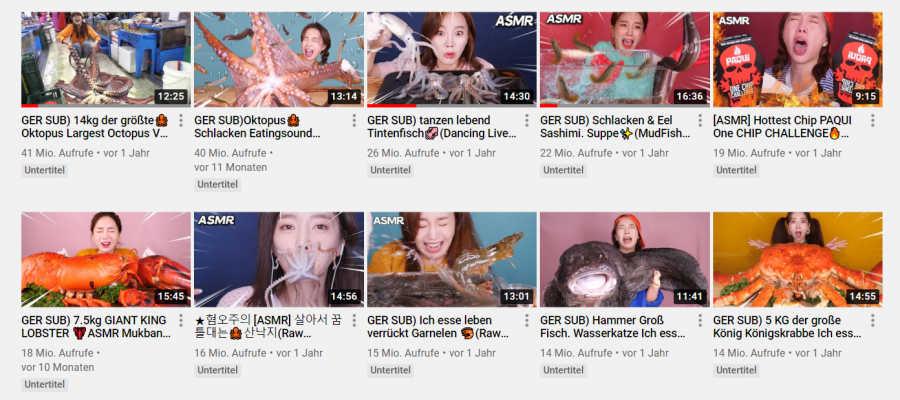
Ssoyoung's Top 10 most viewed videos
YouTube, what are you doing?
YouTube’s community guidelines clearly state that violent or graphic content is not allowed on the platform which includes “Content where there is infliction of unnecessary suffering or harm deliberately causing an animal distress”.
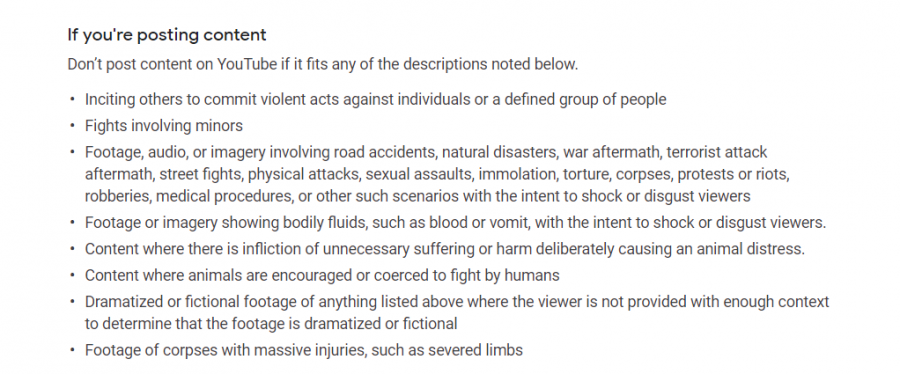
Section of YouTube's community guidelines
And yet, not only do the videos by Ssoyoung and her channel stay public on the platform, but the videos are also still monetized and only few are age restricted. With 5 million subscribers and videos garnering up to 40 million views it is highly unlikely that YouTube is not aware of the content on her channel.
Moderation is all easy-peasy lemon-squeezy
All platforms must moderate the content they are hosting in some way. As complicated and controversial a process this may be, it is an essential part of all platforms (Gillespie, 2018).
There are several aspects that can make content moderation a difficult endeavor for platforms, as well as there are different reasons for why a platform might moderate their content a certain way. There are three main difficulties Gillespie (2018) presents in his book, all of which can be seen at play in the controversy surrounding Ssoyoung.
YouTube’s love-triangle from hell
One of the problems a platform might run into, when it comes to content moderation, is that of catering to a variety of different stakeholders.
According to the YouTube guidelines, they are there to “help keep YouTube fun and enjoyable for everyone”. However, YouTube has gotten increasingly under fire by people calling them out for seemingly moderating content more so in favor of profit margins than to keep the platform enjoyable and safe for its viewers and content creators.
Seeing thatYouTube is a business after all, the need to make a profit is hardly surprising. Therefore, the need to keep advertisers willing to use the platform for their advertisements is crucial. Without content creators to provide content for the users to watch, or with a lack of viewers who watch the content, however, the platform will also lose its advertisers.
With advertisers seemingly not having a problem with, or not being aware of Ssoyoung's video content, and millions of viewers enjoying her videos, it seems that YouTube has no reason to delete her videos except their own community guidelines.
However, many big Youtubers like penguinz0 (formerly Cr1tical), SomeOrdinaryGamers and h3h3productions on the platform are calling for action on YouTube’s side, calling out YouTube’s lack of consistency in moderation with videos being demonetized after a person so much as curses, whilst animal torture is apparently deemed to be “advertiser-friendly”.
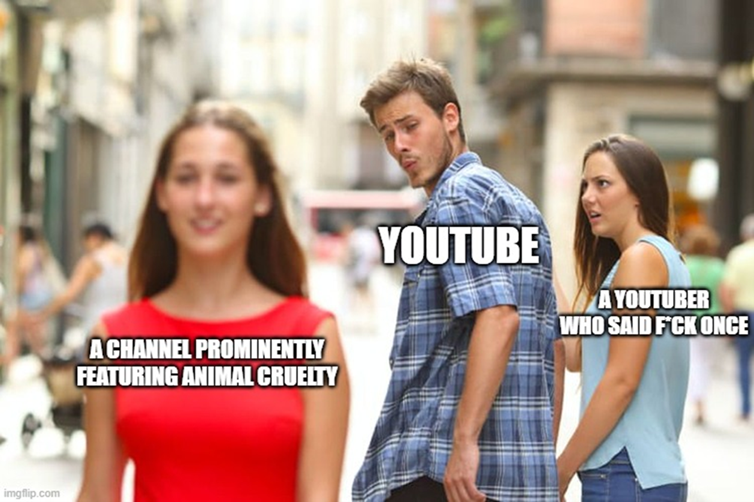
Meme about YouTube's inconsitency moderating content
Who’s your Da- Moderator?
There have also been several complaints about YouTube’s manual review system, and the apparent inconsistency of their decisions. Even big YouTubers like Let’s Player Markiplier, with almost 30 million subscribers, have tried to appeal to YouTube to make the manual review system more transparent.
This however shines a light on another problem platforms like YouTube face: Who should moderate this? With the sheer mass of content uploaded to YouTube every minute, it is not possible for content moderation to be solely in the hands of people. Automatic detection however also has its faults, so YouTube must find a way to combine the two, in an effort to moderate both effectively and fairly.
The culture argument
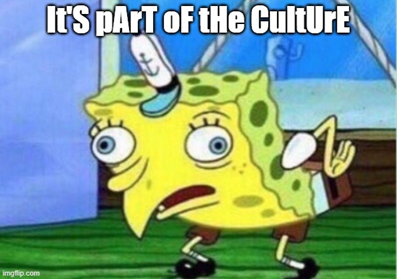
Another problem YouTube might run into when it comes to the moderation of Ssoyoung’s channel is the fact that she is Korean. Korean cuisine is very different from what many people, at least in the western world, consider normal. Cultural norms differ in what is considered acceptable and what is not. As YouTube is an internationally available platform they, just like any other platform, have to take cultural differences into consideration.
So, whilst pouring soy sauce on a live octopus and then eating it alive might be reprehensible in the western world, it might be common practice in Korea. As Youtuber Sherliza Moé pointed out much like many commenters under her videos, YouTube would probably have to fear being called “racist” if they take a stand against her content as it is quickly seen as judgement of another culture.
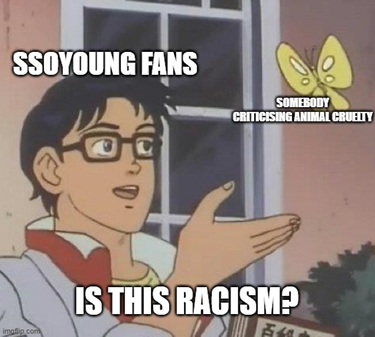
Whilst only few people would argue that respecting other cultures is a bad thing, there are clear issues with this reasoning.
Is it part of the culture??
San-nakji, is the name of a Korean meal which consists of raw, chopped up small octopus. The octopus gets killed and chopped up right before serving so nerve-activity in the tentacles makes it keep moving after having been killed. The key here however is that the octopus is alreadydead. The animals in Ssoyoung’s videos often are not.
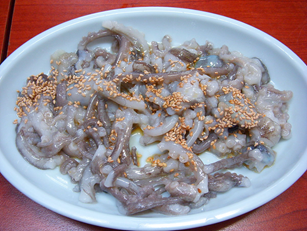
San-nakji
There are other meals in Southeast Asian cuisine like “drunken shrimp”, mainly eaten in China and Japan, which are actually being eaten alive. They are however anesthetized before being eaten.
Several Korean YouTubers like Jojospotlight, YoYoMaing as well as the ReacThing channel have made videos expressing their judgement, disgust, and confusion at her videos. They emphasize that this way of eating is not part of Korean culture. Both just because of the way the food is eaten and because how she is treating the animals. People also criticize how she is “playing with her food” which is very frowned upon in many Asian countries.

Is culture an excuse?
Whilst it does not seem like eating animals alive or torturing them before preparing a meal is part of Korean culture, the question remains if this should be considered a valid reason for videos like this to stay up. After all, we do not condone all practices done by other cultures merely because it is part of a culture.
The Yulin Dog meat festival, or the consumption of dog meat at all is heavily criticized by people all over the world for its cruelty. And videos of dogs being killed, boiled alive or “just” eaten are hardly to be found on YouTube. Though one could argue that it is part of the culture there. Is Korean culture immunized against criticism unlike China? Or is it the animal that is the problem here?
Look at the funny dancing squid
“Dancing life squid” is the name of one of Ssoyoung's videos with over 26 million views. In the video she is seen cutting the hoods off squids, exposing their eye, pouring soy sauce on them, and then eating them. The “dancing” of the squids is made out to be a funny endeavor by Ssoyoung, while the squids are writhing in pain.

Live squids after having their mantle cut off and their eyes exposed
Sea creatures are often not considered to be as much of a living being as other animals. Some argue that they cannot feel pain, though this has been disproven several times for most of them, and others argue that they are not intelligent, or cute enough to deserve being treated humanely. After all, when thinking about animal cruelty, very few think of lobsters being boiled alive.
This disregard of aquatic animal welfare is clearly visible in much of the legislation regarding animal cruelty, which often does not include a variety, or even any sea creatures. And when looking at the likes and comments under SSoyoung’s channel, and the likes on her videos, it appears that the disregard for aquatic animal welfare is still a very normal occurrence among her viewers.
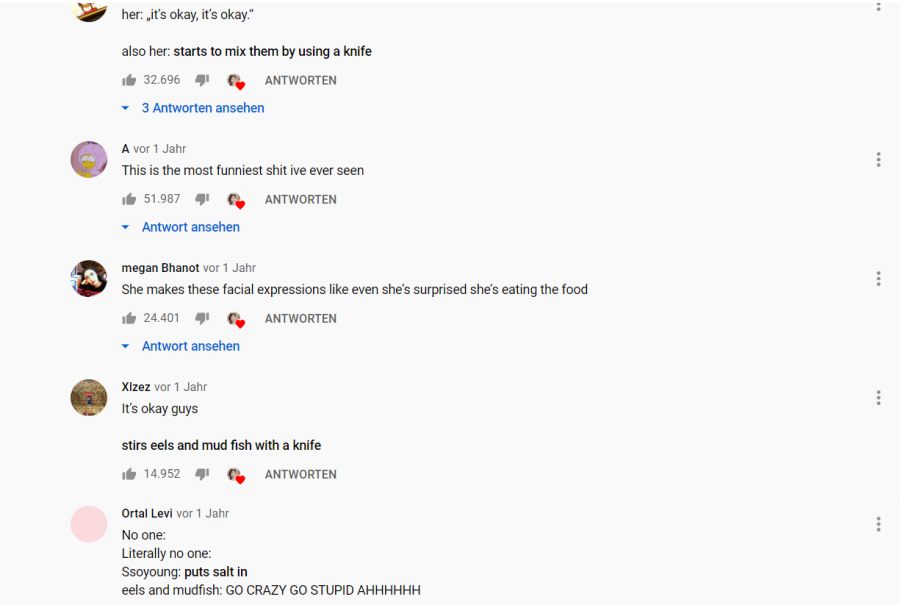
Positive comments under a video showing her pouring salt over live eels
How is this YouTube’s fault?
YouTube is hardly to blame for people’s preconceived notions of which animals can orcannot be tortured. However, the continued spotlight and promotion by the algorithm the platform offers Ssoyoung, despite the nature of her content, helps normalize the treatment of animals shown in her videos.
YouTube has over 2 Billion monthly active users and is the 2nd most visited website worldwide right after Google. With this kind of reach comes an immense power to influence society. Over 500 hours of content are uploaded every minute. To make it possible for people to navigate this avalanche of content YouTube uses what is now, due to its reach, one of the most influential algorithms in the world.
We sure live in a society, huh?
Not just the way culture is experienced and practiced nowadays, but also the way it develops, and changes is greatly influenced by big data and large-scale computation, which includes algorithms. This new development of culture can be referred to as an “algorithmic culture” (Granieri, 2014).
Since the algorithm holds such an immense amount of power, it is important to ensure that it does no harm (Tufekci, 2015). This would mean that harmful content, whilst not allowed in the first place, is certainly not promoted by the algorithm. Because that not only rewards Ssoyoung for the content of her videos, as it increases her income from them, but also promotes this behavior to others, normalizing the cruelty and inspiring copycats like JaeYeol ASMR.
It’s the size that matters
According to YouTube’s Chief Product Officer Neal Mohan, 70 percent of the content consumed by the viewer is driven by YouTube’s recommendation system.
The way in which YouTube’s algorithm calculates which videos to recommend a user appears to be a great mystery to many, as it sometimes appears random in its recommendations.
However, a group of Google engineers published a paper in 2016 which showed their plans for how the YouTube recommendation engine could be used to improve user experience, and with that, get more engagement on their platform.
As their abstract states, “Youtube represents one of the largest scale and most sophisticated industrial recommendation systems in existence” (Covington et al., 2016, p.191). Therefore, saying with certainty which videos it will recommend users is seemingly impossible. There are however several aspects clearly outlined thatcan increase the likelihood of a video to be recommended.

Ssoyoung, the algorithm's wet nightmare
Ssoyoung’s content as well as her channel, not considering the animal cruelty, appears to perfectly cater to these points. Especially when considering that the first two, click-through rate and watch time, work best when combined. After all, YouTube does not just want its users to click on a video (Click-through rate) but also to watch it (Watch time) to get prolonged engagement on their website.
Ssoyoung does not use clickbait in her thumbnails and titles but does create them in a way that gets people to click on them. Her videos are also usually very long, usually lasting for 10 to 20 minutes, which further increases Watch time.
She also uploads daily, meaning that someone who enjoys her content is more likely to watch a lot of her videos very frequently.
Since her videos fall into two very popular genres on YouTube, both Mukbangs as well as ASMR, her videos might be recommended to people who enjoy either of these formats, as it might correlate with previously watched videos and previous searches.
She also provides subtitles for her videos in usually over 10 different languages, making them accessible to a broad audience.
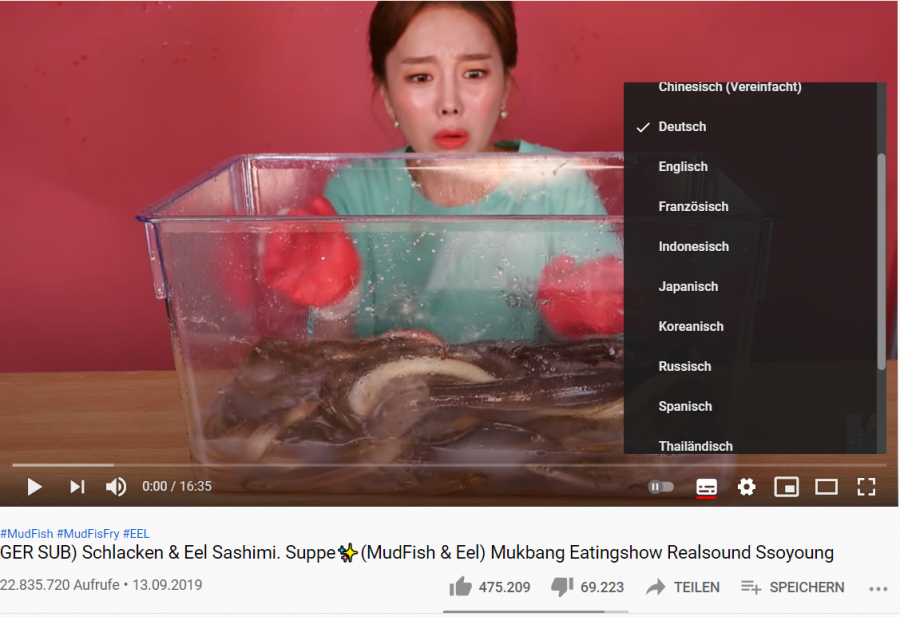
Taking this into consideration, it is hardly surprising that her channel was able to grow so fast in such a short time. And that, some of her most viewed videos are still the first ones to show up when searching for Ssoyoung on YouTube, despite being the ones heavily criticized for showcasing animal torture.
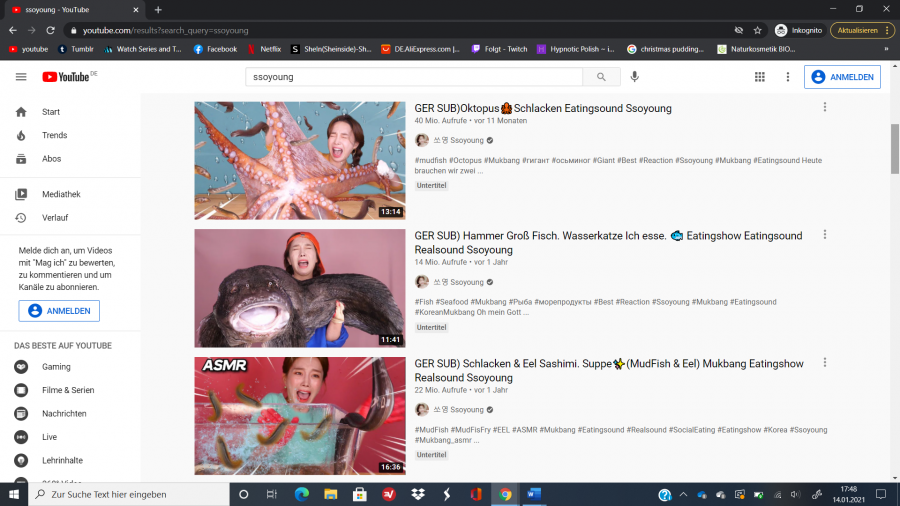
Conclusion
YouTube’s guidelines clearly state that videos featuring animal cruelty are not allowed on their website. However, seeing as Ssoyoung’s videos are still not only available to watch, but monetized, it looks like YouTube has decided to make some exceptions to the rule. Many viewers and creators are showing their outrage in videos, comments as well as in a petition to ban her from YouTube entirely with over 160000 signatures. However, without advertisers demanding their commercials to not be played on her videos, it seems unlikely that YouTube will intervene.
This shines some light both on YouTube’s controversial and inconsistent moderation system as well as on the risks that come with algorithms as influential as that of YouTube's. Videos like those of Ssoyoung being prominently featured on a platform for billions of people to watch does not just shine a bad light on YouTube as a platform but can shape our culture in ways that might not always be favorable.

Some feel-good kittens. I think we all deserve them after reading this.

Some feel-good kittens. I think we all deserve them after reading this.
References:
Aquatic Animal Law Initiative. (o. D.). Center for Animal Law Studies - Lewis & Clark.
Aslam, S. (2021, 6. Januar). YouTube by the Numbers: Stats, Demographics & Fun Facts. Omnicore.
Covington, P., Adams, J. & Sargin, E. (2016). Deep Neural Networks for YouTube Recommendations. Proceedings of the 10th ACM Conference on Recommender Systems, 191–198. https://doi.org/10.1145/2959100.2959190
Gillespie, T. (2018). Custodians of the Internet: Platforms, Content Moderation, and the Hidden Decisions That Shape Social Media (Illustrated Aufl.). Yale University Press.
Granieri, G. (2014). Algorithmic culture. “Culture now has two audiences: people and machines. A conversation with Ted Striphas.
Jaffari, A. (2019, 4. Juli). How the YouTube Algorithm Works (Or Why Your Videos Aren’t Getting Views). Shopify.
Solsman, J. E. (2018, 10. Januar). YouTube’s AI is the puppet master over most of what you watch. CNET.
Sneddon, L. U. (2015). Pain in aquatic animals. Journal of Experimental Biology, 218(7), 967–976.
Tufekci, Zeynep (2015). Algorithmic harms beyond Facebook and Google: Emergent challenges of computational agency. Colorado Technology Law Journal 13(2)
YouTube’s Community Guidelines - YouTube Help. (o. D.). Youtube Community Guidelines.